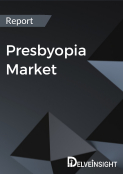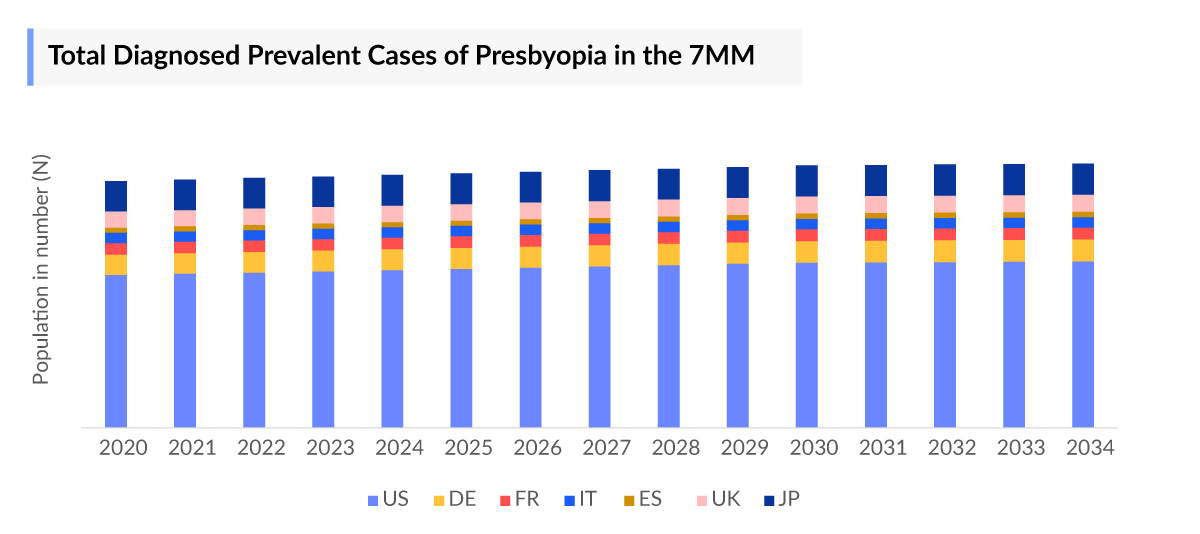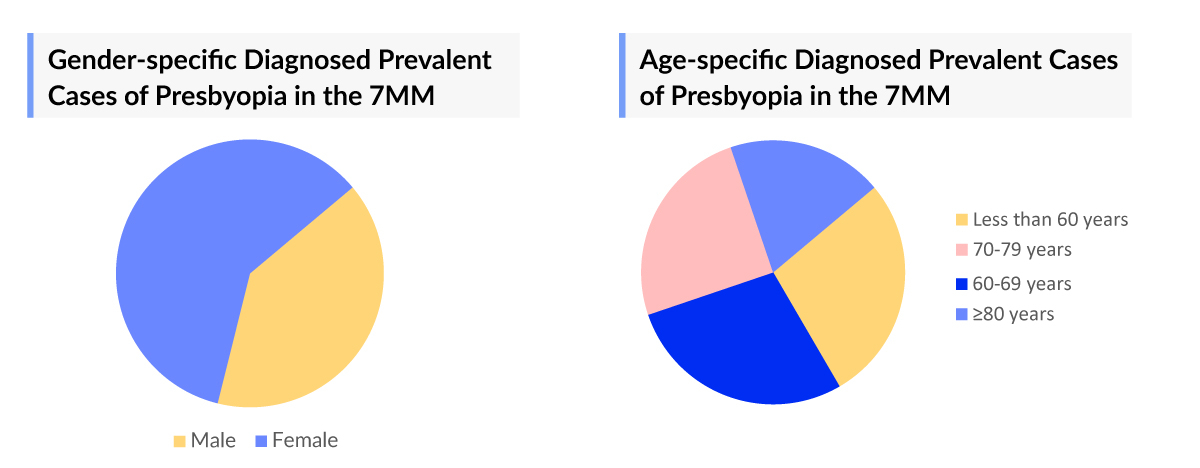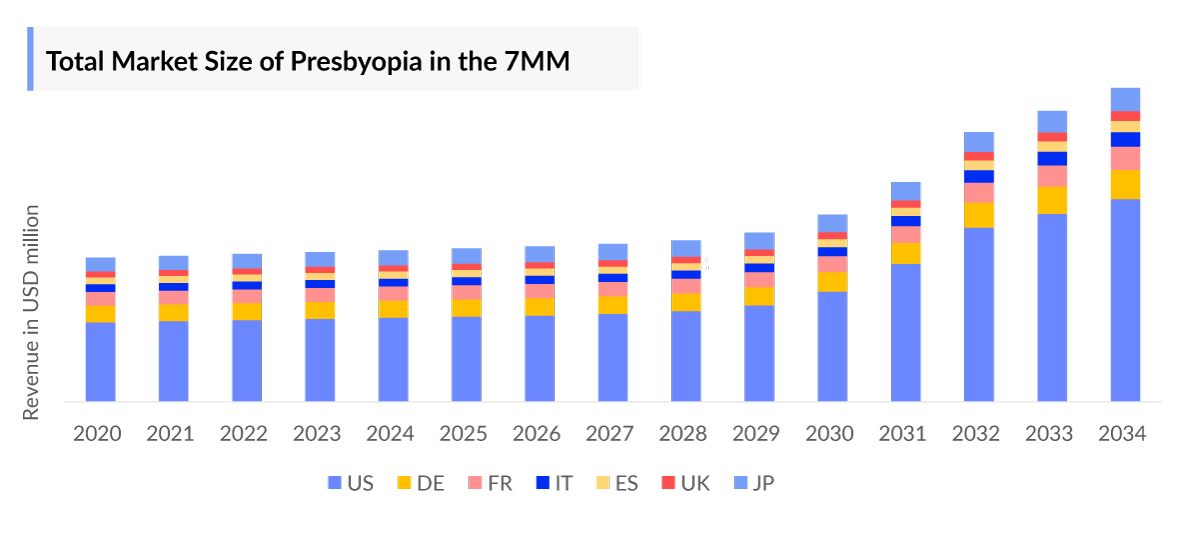Presbyopia Market
- The Presbyopia Market Size in the 7MM was ~USD 17,000 million in 2023 and is anticipated to grow with a significant CAGR during the study period (2020-2034).
- According to DelveInsight’s estimates, the total diagnosed prevalent cases of presbyopia in the 7MM, were ~278 million; the number of these cases is expected to increase by 2034.
- In 2023, the Presbyopia Market Size was highest in the US among the 7MM, accounting for approximately USD 8,039 million which is further expected to increase by 2034.
- The current Presbyopia Treatment includes VUITY (market size of ~USD 257 million in 2023, in the 7MM), an approved drug for the Presbyopia treatment.
- The different pharmacological therapies used to treat presbyopia belong mainly to classes of parasympathomimetics or cholinomimetics used for the management of the disease.
- The emerging drug Phentolamine Ophthalmic Solution 0.75% (PS) and is expected to launch in the US by 2025, in EU4 and the UK by 2026, and in Japan by 2027, which has the potential to reduce the disease burden of presbyopia in the forecasted years.
Request for Unlocking the Sample Page of the "Presbyopia Treatment Market"
DelveInsight’s “Presbyopia Market Insights, Epidemiology, and Market Forecast – 2034” report delivers an in-depth understanding of presbyopia, historical and forecasted epidemiology as well as the presbyopia therapeutics market trends in the United States, EU4, and the UK (Germany, France, Italy, Spain) and the United Kingdom, and Japan.
The Presbyopia Treatment Market Report provides current treatment practices, emerging drugs, market share of individual therapies, and current and forecasted 7MM presbyopia market size from 2020 to 2034. The Report also covers current presbyopia treatment practices, market drivers, market barriers, SWOT analysis, reimbursement and market access, and unmet medical needs to curate the best of the opportunities and assess the underlying potential of the market.
| Study Period | 2020 to 2034 |
| Forecast Period | 2024-2034 |
| Geographies Covered |
|
| Presbyopia Market |
|
| Presbyopia Market Size | |
| Presbyopia Companies |
|
Presbyopia Treatment Market
Presbyopia is a common age-related condition characterized by a gradual loss of near-focusing ability, typically becoming noticeable after age 40 and progressing between the ages of 40 and 60. This decline in near vision results from the natural aging process, where the lenses of the eyes lose elasticity due to age-related changes in the proteins within the lens, causing it to thicken, harden, and become less flexible. These changes impair the lens's ability to refract light rays properly, diminishing the eye's focusing capacity. Presbyopia can be categorized into several types, including incipient, functional, absolute, premature, and nocturnal presbyopia.
While aging is the primary risk factor for presbyopia, the condition can also manifest prematurely due to factors such as trauma, systemic diseases, cardiovascular conditions, or drug side effects. Early symptoms often include difficulty with prolonged close-up tasks and eye strain, which may worsen in dim light. Other common symptoms encompass delays in focusing at various distances, ocular discomfort, headaches, asthenopia, squinting, fatigue or drowsiness from near work, increased working distance, a need for brighter light when reading, and diplopia. Understanding these mechanisms and symptoms is crucial for the effective management and treatment of presbyopia.
Presbyopia Diagnosis
Diagnosing presbyopia involves a comprehensive eye examination by an ophthalmologist, including assessments of the retina, muscle integrity, refraction, slit-lamp evaluation, visual field, and visual acuity. An ophthalmoscope is used to examine the retina, optic disk, and choroid. Muscle integrity is assessed by observing the patient's ability to follow a moving object. Refractive tests determine how well light waves bend through the cornea and lens to identify the correct lens prescription. A slit-lamp exam provides a magnified view of the eye's anterior structures, while visual field tests measure peripheral vision, and visual acuity tests assess clarity at various distances. Pupil-dilating eye drops may be used, temporarily increasing light sensitivity. These evaluations ensure accurate diagnosis and overall ocular health.
Further details related to diagnosis are provided in the report…
Presbyopia Treatment
Treatment of presbyopia involves various options tailored to the patient's vocational and avocational needs, aiming to compensate for the eye's reduced ability to focus on nearby objects. Optical correction can be achieved through corrective eyeglasses (spectacle lenses) or contact lenses, and for those seeking more permanent solutions, refractive surgery or lens implants are viable options. Refractive surgical procedures include techniques such as Conductive Keratoplasty, LASIK, LASEK, and Photorefractive Keratectomy, which have become safer and more effective with advancements in technology. Additionally, current clinical management may involve off-label use of nonsteroidal anti-inflammatory drugs (NSAIDs), parasympathetic agonists, miotic agents, and other tempering agents. Commonly used agents in these treatments include Pilocarpine, Carbachol, Aceclidine, Brimonidine, and Nepafenac. Each treatment option is considered based on the specific needs and conditions of the patient, providing a comprehensive approach to managing presbyopia.
Presbyopia affects a significant segment of the aging population, yet existing treatments often fall short in terms of cost and accessibility. Advanced surgical options are prohibitively expensive and typically not covered by insurance, creating a barrier for many individuals. There is an urgent demand for affordable, non-invasive solutions that cater to diverse socioeconomic backgrounds.
While topical agents like pilocarpine drops, including the pioneering VUITY, represent a step forward, they have not fully met expectations. The daily cost of approximately USD 3 for a 30-day supply, coupled with a lack of insurance coverage, renders them impractical for many. Real-world feedback and AbbVie’s reduction in marketing efforts underscore the need for more effective treatments with fewer applications and longer-lasting effects. Addressing these gaps is crucial for enhancing the quality of life for those affected by presbyopia.
Presbyopia Epidemiology
As the market is derived using a patient-based model, the Presbyopia epidemiology chapter in the report provides historical as well as forecasted epidemiology segmented by, Total Prevalent Cases of Presbyopia, Total Diagnosed Prevalent Cases of Presbyopia, Age-specific Diagnosed Prevalent Cases of Presbyopia, Gender-specific Diagnosed Prevalent Cases of Presbyopia, and Severity-specific Diagnosed Prevalent Cases of Presbyopia, in the 7MM covering, the United States, EU4 countries (Germany, France, Italy, and Spain), United Kingdom, and Japan from 2020 to 2034.
- In the assessment done by DelveInsight, the estimated total prevalent cases of presbyopia in the 7MM were ~325 million in 2023.
- The highest total diagnosed prevalent cases of Presbyopia were accounted by the US in 2023 (~109 million), which is expected to show a rise in the future.
- Among the European countries, Germany had the highest diagnosed prevalent cases of presbyopia with ~32 million cases, followed by Italy, which had diagnosed prevalent population of ~24 million in 2023. On the other hand, Spain had the lowest diagnosed prevalent population (~18 million cases).
- Japan had ~50 million total diagnosed prevalent cases of Presbyopia in 2023, accounting for approximately 18% in 7MM.
- In 2023, in the US, the gender-specific diagnosed prevalent cases of presbyopia were highest for females (~60%), as compared to males (~40%), which is attributed to factors such as hormonal differences, ocular anatomy and physiology, lifestyle and occupational factors and others.
- The age-specific instances of presbyopia in the 7MM were highest for the age group 60–69 (~78 million cases), followed by the age group of less than 60 years (~77 million cases), 70–79 years (~69 million cases), and the age group =80 years (~53 million) in 2023.
- In 2023, presbyopia cases were further sub-segmented based on severity into mild and moderate to severe. Among the 7MM, the highest diagnosed prevalence was observed in moderate to severe, with ~212 million cases, compared to ~56 million mild cases.
Unlock comprehensive insights! Click Here to Purchase the Full Epidemiology Report @ Presbyopia Prevalence
Presbyopia Drug Chapters
The drug chapter segment of the Presbyopia Therapeutics Market Report encloses a detailed analysis of Presbyopia off-label drugs and late-stage (Phase-III and Phase-II) Presbyopia pipeline drugs analysis. It also helps to understand the Presbyopia clinical trials details, expressive pharmacological action, agreements and collaborations, approval and patent details, advantages and disadvantages of each included drug, and the latest Presbyopia news and press releases.
Presbyopia Marketed Drugs
- VUITY (pilocarpine HCI ophthalmic solution) 1.25%: Allergan/AbbVie
VUITY (pilocarpine HCI ophthalmic solution) 1.25%, developed by Allergan, is a novel treatment for presbyopia approved by the US FDA In October 2021. This prescription eye drop works by contracting the pupil to enhance near and intermediate vision without significantly affecting distance vision. By leveraging the miotic properties of pilocarpine, VUITY improves focus for close-up tasks, offering a non-invasive alternative to reading glasses. Its approval marks a significant advancement in presbyopia management, providing patients with a convenient and effective option to alleviate the condition's symptoms.
Approved but not launched yet:
- QLOSI (pilocarpine hydrochloride ophthalmic solution) 0.4%: Orasis Pharmaceuticals
QLOSI (pilocarpine hydrochloride ophthalmic solution) 0.4%, developed by Orasis Pharmaceuticals, is a novel treatment for presbyopia that was approved by the US FDA in October 2023. This formulation aims to improve near vision by using pilocarpine, a cholinergic muscarinic agonist, to enhance the eye's accommodative ability. The market launch of QLOSI is anticipated in the second half of 2024, offering a new option for patients seeking a non-surgical approach to managing age-related vision decline. The cost of Qlosi varies based on region, insurance coverage, and dosage, impacting accessibility for patients requiring prescriptive ophthalmic treatment.
Presbyopia Emerging Drugs
- Brimochol PF (VT-1011): Visus Therapeutics
Brimochol PF (VT-1011), which is being developed by Visus Therapeutics, is a novel treatment for presbyopia. This investigational eye drop formulation combines brimonidine, a selective alpha-2 adrenergic agonist, with carbachol, a muscarinic agonist, to improve near vision by enhancing the eye's accommodative response. Currently, Brimochol PF is in the late stages of clinical development, having completed Phase III trials, which have demonstrated its efficacy and safety profile. The product is expected to have its New Drug Application (NDA) filed in the second half of 2024, aiming to offer a new therapeutic option for managing presbyopia.
- LNZ100 - 1.75% Aceclidine: LENZ Therapeutics, Inc.
LNZ100 - 1.75% Aceclidine, developed by LENZ Therapeutics, Inc., is a promising treatment for presbyopia. This formulation utilizes Aceclidine, a parasympathomimetic agent, to improve near vision by enhancing the eye's accommodative response. Currently, LNZ100 is in advanced clinical stages, with the company planning to submit an NDA to the FDA in mid-2024. The projected market launch for LNZ100 is targeted for the second half of 2025, positioning it as a key therapeutic option for managing presbyopia.
Explore the latest advancements in Presbyopia therapies with the latest 2025 pipeline insights.
Presbyopia Market Outlook
The Market for Presbyopia treatments encompasses a diverse range of options, catering to various patient preferences and needs. Non-invasive solutions, such as reading glasses, bifocals, and progressive lenses, offer clear vision at different distances, making them popular among those seeking convenience. Contact lenses, including multifocal and monovision types, further enhance flexibility and field of vision compared to traditional eyewear.
Pharmacological treatments have emerged as promising options. Eye drops like pilocarpine hydrochloride temporarily enhance near vision by constricting the pupil, thus improving depth of field. Among the notable advancements, FDA-approved treatments such as VUITY and QLOSI represent significant progress. Despite these advancements, the market for presbyopia treatments is still evolving. The current FDA-approved therapies are limited, highlighting a significant gap in available treatment options. This gap presents opportunities for further innovation and development in the field, as there remains a substantial demand for new, effective solutions to address the diverse needs of individuals with presbyopia.
In the upcoming Presbyopia Treatment Market Landscape, there are a plethora of companies investigating agents for use in presbyopia which includes Visus Therapeutics and others. There are many more pharma companies which are conducting clinical trials for therapies for presbyopia.
- The Presbyopia Therapeutics Market Size in the 7MM was approximately USD 17,000 million in 2023.
- The United States accounted for the highest Presbyopia Therapeutics Market Size approximately 48% of the total market size in 7MM in 2023, in comparison to the other major markets i.e., EU4 countries (Germany, France, Italy, and Spain), and the United Kingdom, and Japan.
- Among the European countries, Germany had the highest Presbyopia Treatment Market Size with nearly USD 1,666 million in 2023, while Spain had the lowest Presbyopia Treatment Market Size with ~USD 938 million in 2023.
- The Presbyopia Treatment Market Size in Japan was estimated to be ~USD 2642 million in 2023, which accounts for 16% of the total 7MM market.
- With the expected launch of upcoming therapies, such as LNZ100 (Aceclidine) the total Presbyopia Treatment Market Size is expected to show change in the upcoming years.
Presbyopia Drugs Uptake
This section focuses on the uptake rate of potential Presbyopia drugs expected to launch in the market during 2020–2034. For example, LNZ100 (Aceclidine) in the US is expected to be launched by 2025 with a peak share of 2%. Aceclidine is anticipated to take 7 years to peak with a medium uptake.
Presbyopia Pipeline Development Activities
The Presbyopia Therapeutics Market Report provides insights into different Presbyopia clinical trials within Phase III, Phase II, and Phase I. It also analyzes key Presbyopia Companies involved in developing targeted therapeutics.
Pipeline Development Activities
The Presbyopia Therapeutics Market Report covers information on collaborations, acquisitions and mergers, licensing, and patent details for Presbyopia emerging therapies.
KOL Views
To keep up with current market trends, we take KOLs and SMEs’ opinions working in the domain through primary research to fill the data gaps and validate the secondary research. Industry Experts were contacted for insights on Presbyopia evolving treatment landscape, patient reliance on conventional therapies, patient therapy switching acceptability, and drug uptake along with challenges related to accessibility, including KOL from The Midwest Center for Sight, Des Plaines; University of California, San Francisco; Department of Ophthalmology, Universitätsmedizin, Mannheim; Department of Ophthalmology, University Hospital Morvan; Studi Medici Renna, Melendugno Lecce, Italy; Universidad Miguel Hernandez, Spain; Department of Ophthalmology, Kyorin University School of Medicine, Tokyo; and others.
Delveinsight’s analysts connected with 50+ KOLs to gather insights; however, interviews were conducted with 15+ KOLs in the 7MM. Their opinion helps understand and validate current and emerging therapies, treatment patterns, or Presbyopia market trends. This will support the clients in potential upcoming novel treatments by identifying the overall scenario of the market and the unmet needs.
Qualitative Analysis
We perform Qualitative and Presbyopia Market Intelligence analysis using various approaches, such as SWOT and Conjoint Analysis. In the SWOT analysis, strengths, weaknesses, opportunities, and threats in terms of disease diagnosis, patient awareness, patient burden, competitive landscape, cost-effectiveness, and geographical accessibility of therapies are provided. These pointers are based on the Analyst’s discretion and assessment of the patient burden, cost analysis, and existing and evolving Presbyopia Treatment Market Landscape.
Conjoint Analysis analyzes multiple approved and emerging therapies based on relevant attributes such as safety, efficacy, frequency of administration, route of administration, and order of entry. Scoring is given based on these parameters to analyze the effectiveness of therapy.
Further, the therapies’ safety is evaluated wherein the acceptability, tolerability, and adverse events are majorly observed, and it sets a clear understanding of the side effects posed by the drug in the trials. In addition, the scoring is also based on the route of administration, order of entry and designation, probability of success, and the addressable patient pool for each therapy. According to these parameters, the final weightage score and the ranking of the emerging therapies are decided.
Presbyopia Therapeutics Market Access and Reimbursement
The high cost of therapies for the treatment is a major factor restraining the growth of the global Presbyopia drugs market. Because of the high cost, the economic burden is increasing, leading the patient to escape from proper treatment. The report further provides detailed insights on the country-wise accessibility and reimbursement scenarios, cost-effectiveness scenario of approved therapies, programs making accessibility easier and out-of-pocket costs more affordable, insights on patients insured under federal or state government prescription drug programs, etc.
Scope of the Presbyopia Therapeutics Market
- The Presbyopia Therapeutics Market Report covers a segment of key events, an executive summary, and a descriptive overview, explaining its causes, signs and symptoms, and currently available therapies.
- Comprehensive insight has been provided into the epidemiology segments and forecasts, the future growth potential of diagnosis rate, disease progression, and treatment guidelines.
- Additionally, an all-inclusive account of the current and emerging therapies and the elaborative profiles of late-stage and prominent therapies will impact the current Presbyopia Treatment Market Landscape.
- A detailed review of the Presbyopia Drugs Market, historical and forecasted Presbyopia Treatment Market Size, Presbyopia Drugs Market Share by therapies, detailed assumptions, and rationale behind the approach is included in the report covering the 7MM drug outreach.
- The Presbyopia Therapeutics Market Report provides an edge while developing business strategies, by understanding trends, through SWOT analysis and expert insights/KOL views, patient journey, and treatment preferences that help shape and drive the 7MM Presbyopia Drugs Market.
Presbyopia Therapeutics Market Report Insights
- Patient-based Presbyopia Market Forecasting
- Presbyopia Therapeutic Approaches
- Presbyopia Pipeline Drugs Analysis
- Presbyopia Market Size and Trends
- Existing and Future Presbyopia Drugs Market Opportunities
Presbyopia Therapeutics Market Report Key Strengths
- 11 years Presbyopia Market Forecast
- The 7MM Coverage
- Presbyopia Epidemiology Segmentation
- Key Cross Competition
- Conjoint Analysis
- Presbyopia Drugs Uptake
- Key Presbyopia Market Forecast Assumptions
Presbyopia Therapeutics Market Report Assessment
- Current Presbyopia Treatment Market Practices
- Presbyopia Unmet Needs
- Presbyopia Pipeline Drugs Analysis Profiles
- Presbyopia Drugs Market Attractiveness
- Qualitative Analysis (SWOT and Conjoint Analysis)
- Presbyopia Market Drivers
- Presbyopia Market Barriers
Key Questions Answered In The Presbyopia Market Report:
Presbyopia Treatment Market Insights
- What was the presbyopia drugs market share (%) distribution in 2020 and what it would look like in 2034?
- What would be the presbyopia treatment market size as well as market size by therapies across the 7MM during the forecast period (2024–2034)?
- What are the key findings pertaining to the market across the 7MM and which country will have the largest presbyopia market size during the forecast period (2024–2034)?
- At what CAGR, the presbyopia drugs market is expected to grow at the 7MM level during the forecast period (2024–2034)?
- What would be the presbyopia market outlook across the 7MM during the forecast period (2024–2034)?
- What would be the presbyopia market growth till 2034 and what will be the resultant market size in the year 2034?
- How would the market drivers, barriers, and future opportunities affect the market dynamics and subsequent analysis of the associated trends?
Presbyopia Epidemiology Insights
- What are the disease risk, burden, and Presbyopia Unmet Needs?
- What is the historical presbyopia patient population in the United States, EU4 (Germany, France, Italy, Spain) and the UK, and Japan?
- What would be the forecasted patient population of presbyopia at the 7MM level?
- What will be the growth opportunities across the 7MM with respect to the patient population pertaining to presbyopia?
- Out of the above-mentioned countries, which country would have the highest prevalent population of presbyopia during the forecast period (2024–2034)?
- At what CAGR the population is expected to grow across the 7MM during the forecast period (2024–2034)?
Current Presbyopia Treatment Market Scenario, Marketed Drugs, and Emerging Therapies
- What are the current options for the treatment of presbyopia along with the approved therapy?
- What are the current treatment guidelines for the treatment of presbyopia in the US, Europe, And Japan?
- What are the presbyopia-marketed drugs and their MOA, regulatory milestones, product development activities, advantages, disadvantages, safety, efficacy, etc.?
- How many companies are developing therapies for the treatment of presbyopia?
- How many emerging therapies are in the mid-stage and late stages of development for the treatment of presbyopia?
- What are the key collaborations (Industry–Industry, Industry-Academia), Mergers and acquisitions, and licensing activities related to the presbyopia therapies?
- What are the recent therapies, targets, mechanisms of action, and technologies developed to overcome the limitations of existing therapies?
- What are the clinical studies going on for presbyopia and their status?
- What are the key designations that have been granted for the Presbyopia Emerging Therapies?
- What are the 7MM historical and forecasted Presbyopia Drugs Market?
Reasons to Buy Presbyopia Market Forecast Report
- The Presbyopia Therapeutics Market Report will help in developing business strategies by understanding the latest trends and changing treatment dynamics driving the Presbyopia Drugs Market.
- Insights on patient burden/disease incidence, evolution in diagnosis, and factors contributing to the change in the epidemiology of the disease during the forecast years.
- To understand the existing Presbyopia Drugs Market opportunity in varying geographies and the growth potential over the coming years.
- Distribution of historical and current patient share based on real-world prescription data along with reported sales of approved products in the US, EU4 (Germany, France, Italy, and Spain), the United Kingdom, and Japan.
- Identification of strong upcoming players in the Presbyopia Drugs Market will help in devising strategies that will help in getting ahead of competitors.
- Detailed analysis and potential of current and emerging therapies under the conjoint analysis section to provide visibility around leading emerging drugs.
- Highlights of Access and Reimbursement policies of approved therapies, barriers to accessibility of off-label expensive therapies, and patient assistance programs.
- To understand the perspective of Key Opinion Leaders around the accessibility, acceptability, and compliance-related challenges of existing treatment to overcome barriers in the future.
- Detailed insights on the unmet needs of the existing Presbyopia Drugs Market so that the upcoming players can strengthen their development and launch strategy.
Stay Updated with us for Recent Articles




